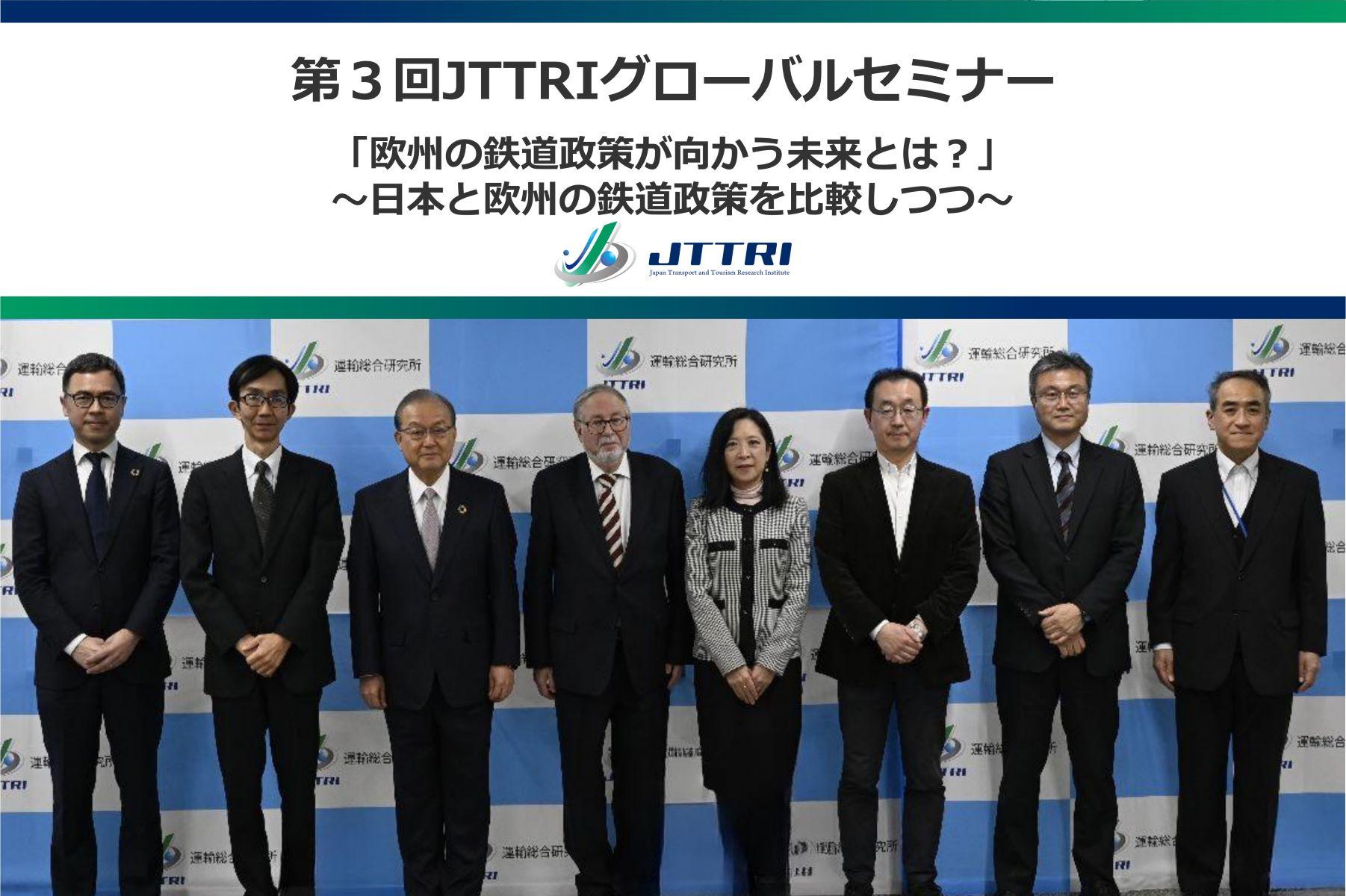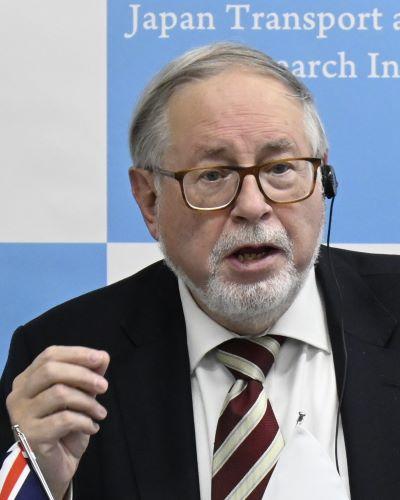3rd JTTRI Global Seminar
“What Does the Future Hold for European Railway Policies? Considering Also Comparisons between Japanese and European Railway Policies”
- Symposium etc.
- International Activities
- Railways and Railway and Area Development


| Date / Time | Mon, Jan 22,2024 14:00 – 17:00 |
|---|---|
| Venue | JTTRI’s Conference Room on the 2nd Floor and Online (Hybrid) |
| Theme | (1) Opening Address SHUKURI Masafumi (Chairman, JTTRI) (2) Guest Greeting TANAKA Yuki (Director General for International Affairs, Ministry of Land, Infrastructure, Transport and Tourism) (3) Keynote Address: “Railway situation and present policies: UK, EU and comparisons with Japan” Roderick A SMITH (Professor Emeritus, Department of Mechanical Engineering, Future Rail Research Centre Chair, Imperial College London. Formerly Chief Scientific Advisor Department for Transport, Past President Institution of Mechanical Engineers) (4) Panel Discussion Panelists: Professor Emeritus Roderick A SMITH UTSUNOMIYA Kiyohito (Professor, Faculty of Economics, Kansai University) KATO Hironori (Professor, Department of Civil Engineering, The University of Tokyo) [Moderator] AIDA Kazuhiko (Manager, Global Railway Business Dept., International Affairs Headquarters, East Japan Railway Company) AGATSUMA Koji (Corporate Officer, Hitachi Ltd. Chief Technology Officer - Vehicles, Railway Systems Business Unit & Hitachi Rail STS USA, Board Director) (5) Q&A + Wrap-up (6) Closing Remarks FUJISAKI Koichi (Distinguished Research Fellow, Director General for Research, JTTRI) |
Event Summary
The Japan Transport and Tourism Research Institute (JTTRI) has invited the Imperial Collage London Future Rail Research Centre Chair, Professor Emeritus Roderick A SMITH, formerly Chief Scientific Advisor for the Department for Transport. He will deliver a keynote address on “Railway situation and present policies: UK, EU and comparisons with Japan” in the context of the response to the effects of the COVID-19 pandemic, as well as in relation to decarbonisation policy. His keynote will touch upon a wide range of topics, such as the Trans-European Transport Network rail, progress of High-Speed 2, weakness in the privatisation model in the UK and reform through the establishment of Great British Railways and its possible revision.
Following the keynote address, four distinguished Japanese academic professionals in the fields of economics and transport engineering and practitioners from current railway projects in UK will join in a panel discussion reflecting on their joint interest in overseas developments in the railway sector. The participants are encouraged to make comparisons between Japan and Europe in the railway sector.





ENGLISH Program(Click here)
Program of the seminar is as the following
| Opening Address |

SHUKURI Masafumi (Chairman, JTTRI) |
|---|---|
| Guest Greeting |

TANAKA Yuki (Director General for International Affairs, Ministry of Land, |
| Keynote Address |

“Railway situation and present policies: UK, EU and comparisons with Japan” File File(Bibliography) |
| Panel Discussion |
<Panelists> Professor Emeritus Roderick A SMITH  UTSUNOMIYA Kiyohito (Professor, Faculty of Economics, Kansai University)  Bio File KATO Hironori (Professor, Department of Civil Engineering,The University of Tokyo) [Moderator]  Bio File AIDA Kazuhiko (Manager, Global Railway Business Dept., International Affairs Headquarters, East Japan Railway Company)  Bio File AGATSUMA Koji (Corporate Officer, Hitachi Ltd. Chief Technology Officer - Vehicles, Railway Systems Business Unit & Hitachi Rail STS USA, Board Director)  Bio |
| Closing Remarks |

FUJISAKI Koichi (Distinguished Research Fellow, Director General for Research, JTTRI) |
Outline of the seminar
■Keynote Address
Roderick A SMITH Imperial College London Professor Emeritus
“Railway situation and present policies: UK, EU, and comparisons with Japan”
I would like to consider the railway policies in the UK and EU in particular, and compare them with Japan. Infrastructure maintenance costs are an issue facing railways, but it is important to consider political control in the history of railways, and it still remains unresolved in many countries.
The Liverpool and Manchester Railway, which opened in 1830, was the world’s first intercity railway, and brought about major changes to society in terms of transport volume and potential in the time and distance required for travel. In the United States, the Baltimore and Ohio Railroad opened around 1830, and in Japan, a railroad between Shimbashi and Yokohama opened in 1872. In the UK and United States, there was initially very little government intervention or interest in railways. They were maintained by the private sector, with no overall plan and a laissez-faire approach. In France and Germany, the government had an understanding of railways from the beginning, and Italy had a partially unified railway system. However, governments soon recognized the military and strategic importance of railways, and started to take considerable interest in them.
From the end of the 19th century until World War I, various railways were introduced in Western Europe, and they were considered to be a comfortable means of travel. However, they were destroyed in World War I, requiring many repairs, and revenues decreased, particularly during the Great Depression of the 1920s and 1930s. In the UK, 120 small companies were vertically integrated into four major private corporations (Great Western Railway (GWR), London, Midland and Scottish Railway (LMS), London North Eastern Railway (LNER), and Southern Railway (SR)). The long-distance railway running between London and Scotland was extremely fast, and the speed record of 203km/h achieved in 1938 still stands today. During this time, Japan also improved its railway technology, and the South Manchuria Railway’s Pashina-type steam locomotive with its 2m wheels were called the Yokozuna of Japanese steam locomotives.
When World War II broke out, railway systems were largely destroyed, except in the United States. Britain’s railways were crippled at the end of the war, and were consolidated into British Railways (BR), with one vertically integrated railway covering the entire nation.
I was born just after the war, in 1947, and I have fond memories of helping my grandfather repair steam locomotives, but unfortunately, many lines were discontinued in the 60s and 70s.
This was due to the “Beeching Report,” which called for the closure of 3,000 miles of railway lines and streamlining to increase railway profitability. Meanwhile, improvements were made in the road transportation network, and the policy trend was that automobiles, which enabled quick and comfortable travel from anywhere, were the future of transportation.
As roads became more congested and environmental concerns arose, people began to question whether it was okay to continue building road networks, and it was around this time that a train called the Trans Europ Express (TEE) was introduced. This initiative was led by Western Europe and was particularly developed in France, and a high-speed railway called the TGV also opened in 1981, long after the Shinkansen was launched in Japan in 1964. Although unified on the map, each country cherished their own traditions and methods.
From the perspective of European integration and in conjunction with the Schengen Agreement, the free movement of labor, which had been limited to Western Europe, expanded across Europe with the accession of East European countries to the EU in 2004. The EU grew to comprise 27 member countries with a population of 450 million, accounting for 6% of the world population. Still, France, Germany, and the UK, which has left the EU, have the largest passenger transportation volumes, at around 70-100 billion passenger-kilometers, while other member countries have little transportation volume, and this falls far short of Japan’s 450 billion passenger-kilometers.
When you look at the transportation mode share in the UK from 1952 onwards, you can see that car ownership rapidly increased, and although it stabilized around 1970, it still accounts for an overwhelming share of the total. The use of railways, which used to account for just under 20%, further decreased and is now at around 10%. However, the passenger transportation volume that combines all modes of transport is steadily increasing.
In 1988, five years before it was privatized in 1993, British Rail was reorganized into three sectors: “InterCity,” a long-distance train service between major cities, “Network SouthEast,” which meets commuting demand to London, and “Regional Railways,” which covers the suburban areas. Regional Railways had low passenger numbers and was unprofitable, but politicians argued that it was necessary to ensure people’s quality of life, and that it had social significance. Although the three sectors achieved a certain level of success with their vertically integrated structure, the wave of privatization came in the late 1980s to early 1990s. Privatization was extremely complex, with “Railtrack” owning the infrastructure, the “Rolling Stock Leasing Companies (ROSCOs)” owning the rolling stock, and the train operating companies that actually provided the service leasing the tracks from Railtrack and the rolling stock from ROSCOs. This meant that there was no vertical integration, and various adjustments were needed. Passenger numbers increased substantially since privatization, and this is thought to be due to frustrations over automobiles, such as congested roads and lack of parking spaces. In some areas, fares soared above the inflation rate, and confidence in train punctuality wavered. In addition, company executives from the financial world received salaries that were 20 to 30 times that of train operators, resulting in poor labor relations. Continuing strikes have further eroded confidence in railways, and from the perspective of the business operators, profitability has not increased, and the risk has fallen to the government. Government subsidies have increased since the British Rail era, and it is difficult to call privatization a success, with the worsening profitability of railways. This will likely have an effect on future policy. In terms of safety, although there was a major accident immediately after privatization, safety has improved, and it is now one of the safest railways in Europe. The national railway companies of France, the Netherlands, and Germany have participated in the British railway system, as well as some Japanese operators.
Within Europe, national systems are still strong, and cross-border integration is extremely slow. The EU tried to improve the situation by introducing competition to the railroad market, but this has had the opposite effect due to competition with other modes of transport, and the fact that air travel is cheaper and quicker than rail due to the EU’s strong liberalization measures. Cheap air fares have widened the gap in passenger-km growth between railways and aviation. The EU’s policy to double the number of high-speed rail tracks by 2030 may be better if the goal was to increase the number of users. There will be a major problem in terms of economic efficiency unless there is an increase in the number of users.
The concept of the ambitious Trans-European Transport Network (TEN-T) program is to expand the former TEE to continental Europe.
The concept of the UK’s HS2 is a high-speed railway that will connect London with Northern England and eventually Scotland, and although construction finally began in 2020, all plans for Phase 2 of construction for routes to the north of Birmingham were canceled by October 2023. Approximately 40% of the route between London and Birmingham is tunneled, and although green construction methods were taken for ground excavation and covering due to opponents pointing out environmental concerns, large amounts of concrete were used, and so the carbon footprint of the construction can only be offset if it is used as much in the future as Japan’s Tokaido Shinkansen. The reasons for the cancellation of Phase 2 were due to the maintenance costs per mile between London and Birmingham being much higher than other railway development projects in Europe, partly because of high inflation; a lack of effort to increase support; and a lack of a clear vision regarding the need for the project.
It is extremely difficult to predict the future. All railway trends, such as automation, decarbonization (green power generation, batteries, hydrogen, etc.), new technologies (data analysis, AI, etc.), enhanced service for customers, and train management system investigations, which are particularly important in Europe, should all lead to service improvement, enhanced efficiency, improved customer experience, decreased costs, and increased capacity, and should make railways even more attractive. I predict that the vacuum tube railway concept will not be very important in the future.
The Great British Railway reform to reunify the railways was postponed to the next general election, so it will be subject to political interference once again.
Reports that Japanese firms had withdrawn from the Malaysia-Singapore high-speed rail project and reports that Japanese investors planned to sell off UK rail assets were disappointing. There was a report on the scandal regarding the Fujitsu IT software and the UK Post Office, and I hope that it will not have a negative impact on relations between Japan and the UK.
In Europe, there has been increasing concern due to the struggles of economically powerful countries, political uncertainty, and the rise of nationalism and protectionism incited by immigration issues, etc., and it is necessary for the EU’s leadership to stay abreast of the situation. Although transportation policies are well thought out, they are often idealistic and unrealistic. The big question is where the money will come from. Whether railways can be politically controlled remains important. It is my belief that what is important in railways is the relationships between people, and although technology and management systems also matter, it is people that form the core.
■Panel Discussion
Roderick A SMITH Imperial College London Professor Emeritus
Kiyohito Utsunomiya Professor, Faculty of Economics, Kansai University
Hironori Kato Professor, Department of Civil Engineering, The University of Tokyo [Moderator]
Kazuhiko Aida Manager, Global Railway Business Department, International Affairs Headquarters, East Japan Railway Company
Koji Agatsuma Corporate Officer, Hitachi Ltd.
Railway Systems Business Unit, Chief Technology Officer-Vehicles
& Hitachi Rail STS USA, Board Director
(Q&A + Wrap-up)
Moderator Hironori Kato Professor, Department of Civil Engineering, The University of Tokyo
【1st round】
Comments from the panelists regarding the keynote address
(Professor Utsunomiya)
In Japan, railways account for a high percentage of the transportation modal share. This is due to a business model in which historically, the external economic effects of railways were internalized, being used for shopping, real estate, and leisure, etc., rather than as a simple means of transportation to the city center, and this business model was established in major metropolitan areas. However, in regional central cities with a population of less than 400,000 people, the modal share of railways is only 2%, which is considerably low when compared to regional central cities in Austria with a population of 100,000 or more. In Japan, rather than improving services in rural areas, services have worsened due to cost-cutting, which has led to railways being used even less, resulting in a downward spiral.
In Europe, Public Service Obligations are established, whereby the government imposes the obligation on transportation operators by contract to provide public services. Whereas in Europe, the government provided subsidies to maintain routes during the coronavirus pandemic, no subsidies were provided in Japan, which shows the difference between the two countries.
In addition, Austria has launched a subscription service called Klima ticket, which allows unlimited rides on public transportation for a year at a huge discount, and is promoting fare policies to increase the number of users. In the UK, measures to prioritize railways have been announced as part of the Green Industrial Revolution, such as expanding railways in regional metropolitan areas. Meanwhile, in Japan, there are no such policies in place. They are very behind in this regard, and it was only in the reconstruction plan for the Johana Line-Himi Line in Toyama Prefecture where it was clearly stated for the first time that “the local government will invest in it as a public service.”
(Professor Kato)
As mentioned in Professor Smith’s lecture, one reason for the cancellation of HS2 was rapid inflation. A recent paper published by the research team at Imperial College London, where Professor Smith is an Emeritus Professor, compared the income and expenditure structure of urban transportation worldwide. It reported that when inflation occurs, costs such as railway operating costs increase, but because railways are public services, railway operators are unable to reach an agreement to increase fares, resulting in a decrease in the revenue coverage ratio with respect to operating costs. In the past, the UK experienced inflation due to the oil shock in the 1970s, and the operating cost coverage ratio decreased at that time as well, causing subsidies to be introduced. However, ultimately it appears that this was handled by increasing fares. Although such a solution was implemented on the London Underground, it was not possible to increase fares for the HS2, which had not started operating yet, and so it may be that they were forced to cancel their plans due to inflation.
In Professor Smith’s lecture, he said that the decision to cancel the HS2 was made due to a lack of political will and future vision on the part of the government, but changing the fares may also be a form of political will. Japan may be able to learn from such case studies regarding how railways should respond to rising prices and how to flexibly change fares.
(Mr. Aida)
In JR East’s management vision, the vision for international business is to “establish a business model for international business and provide a richer lifestyle centered in Asia.” In order to achieve this goal, we are developing our international business with two pillars – our mobility business centered on the railway business, and our lifestyle solution business which includes businesses inside and around stations—and we aim to combine these two businesses to achieve a synergistic effect.
Specifically, we are developing our overseas business mainly in Asia, and as for Europe, which was today’s theme, we are still in the business development stage. We are aiming to improve the presence of the JR East Group and collect and provide information by becoming members of international organizations such as UIC(International Union of Railways)and UITP(International Association of Public Transport), participating in conferences, study groups, and expert meetings, as well as having regular meetings and personnel exchanges, etc., with European railway operators (SNCF, Deutsche Bahn, etc.).
In addition, with regards to the UK railway business, we participated in the railway franchise business of West Midlands Trains from 2017 to 2021. Although we temporarily ended our participation in the project because the franchise agreement could not be finalized due to Covid, the UK is in the middle of railway reform, and so we would like to seriously consider participating in the project again if the opportunity arises in the future.
(Mr. Agatsuma)
Increasing infrastructure maintenance costs have become a huge issue in Europe, and Hitachi is trying to contribute to cost reduction through various initiatives.
Hitachi currently has sales in the UK of approximately 130 billion yen in the previous fiscal year, and is conducting support and maintenance for the operation of 286 trainsets. This means that Hitachi supplies rolling stock to almost all of the intercity routes in the UK, and undertakes their service and maintenance. With regards to Hitachi’s rolling stock, the company is aiming to digitize and connect all the rolling stock to the cloud in order to reduce costs. Through our infrastructure status monitoring business using camera footage and services to provide new functions through monthly software updates, we aim to reduce the burden on rolling stock by resolving infrastructure issues and reduce the burden on infrastructure by resolving rolling stock issues, which will help reduce maintenance costs. Furthermore, in the case of the UK, all rolling stock are equipped with cameras to record footage in the event of an accident, and so we have started a service to provide information regarding infrastructure weaknesses by analyzing this footage using AI. We are working to provide these sort of new cost reduction ideas using existing data to customers not only in the UK but across Europe.
(Professor Smith)
First of all, it is important to understand the difference between railways in the UK and in Japan. British railways have not been modernized, and the conditions of the rolling stock and quality of the tracks are greatly inferior to those in Japan. Therefore, maintaining the railway system requires a tremendous amount of maintenance and is costly. Furthermore, there is an environmental initiative in which the goal is to double the modal share of railways, but as this is not feasible with the existing infrastructure, it will be necessary to develop new railway infrastructure. When considering these costs, it is necessary to discuss “why railways exist” and “who will pay for them.” The same thing can be said regarding the cancellation of HS2.
In addition, it is also important to think about how to satisfy passengers. In order to take advantage of the environmentally-friendly nature of railways, it is necessary to increase the number of passengers, but fares are an extremely important element when doing so, as they can also serve as an incentive to use railways. Trust in railways is also important, but the situation of railways in the UK is terrible, with routine delays and suspensions. Ensuring smooth operations and services in the future will require the help of experienced Japanese operators, but it is first necessary to understand that the situation of railways in the UK is completely different from that of Japan.
【2nd round】
Question ①: What points can Japan and Europe, including the UK, learn from each other?
(Professor Utsunomiya)
In Europe, planning guidelines called the “Sustainable Urban Mobility Plan (SUMP)” were established in 2013, and in 2020, a strategy called the “Sustainable and smart mobility strategy” was announced. The city of Manchester in the UK has set a goal of increasing the modal share of public transport, including rail, and cycling/walking to 50% by 2040. Manchester has expanded its light rail system, called Metrolink, by using railway lines from the British Rail era, and the number of users is increasing. Progress is being made throughout Europe towards achieving the goal of creating a sustainable society, but the focus in Japan at present has been on sustainable “railway business.” On the contrary, public transportation and railways exist as a means of creating a sustainable society, which includes environmental and social justice aspects as well. Seeing that rural areas in Japan, which account for over half of Japan’s population, are struggling to operate public transportation, it appears that there are things that we can learn from Europe.
(Professor Kato)
Recently, an increasing number of European doctoral students who are interested in railway disaster countermeasures have been coming to my research lab. When they interview Japanese railway operators, they are surprised to find that whereas in Europe, these countermeasures are basically considered to be a part of the global warming issue, in Japan, they are only seen as part of disaster prevention. The approach to countermeasures naturally differs depending on how the problem is framed. In addition, in Japan, disaster countermeasures are tacit knowledge among the railway operators, but the European students have the idea of organizing the countermeasures of Japanese railway operators and making them available for anyone to use through digital transformation, etc. If the individual efforts and experiences of Japanese railway operators are successfully put together, they may be able to be used for overseas expansion in a completely different context.
(Professor Smith)
I would like to first emphasize vertical integration. People and the continuity of financial resources are also important. In terms of people, in Japan people do not switch jobs very often, and so companies spend a lot of money training people. This was also true in the UK in the past, but no longer takes place. When plans to electrify major routes over five years are scrapped, those involved lose the continuity of skills and training. Even when considering the replacement of rolling stock, skills cannot be maintained unless work is conducted on a continuous basis. Thus, “continuity” is extremely important in funding, electrification, and rolling stock.
There was a mention of resilience, but in rural areas, there are many single-track railways, low bridges, and embankments, and it is difficult to repair equipment that has been damaged due to abnormal weather. Meanwhile, there are few passengers resulting in extremely high costs per passenger-kilometer, which also serves as a reason to discontinue local lines.
Infrastructure between cities is extremely weak. Problems include points failure, cracks in the track, and weakened catenary wires, etc. If we can detect such problems in advance using a system as Hitachi does and reduce maintenance costs, we would like to learn this from Japan.
I always think that the people who take pride in their railway work are the pride of Japan, and this is something we would like to learn from.
Question ②: What is needed in the future for Japanese companies to further enter the railway market in Europe, including the UK?
(Mr. Aida)
The first point is to understand the other side’s circumstances, rules, situation, and society. When bidding for UK rail, I felt that the structure was complex, with the operators, government, and municipalities each being segmentalized. For instance, when a train is delayed, the company of the delayed train temporarily compensates the customer, but afterwards, the train company, infrastructure company, and Network Rail review and negotiate the cause of the delay, which is an extremely time and labor-intensive process. Even if you think that your company’s technology and solutions are superior and try to intervene, if you proceed without understanding the other party’s circumstances, you cannot show them what sort of benefits there are, which makes it difficult to make inroads.
The second point is to learn about the needs of European railway operators, who are worried about the same issues as Japanese railway operators. We have often received questions and exchanged opinions regarding automated driving, introduction of hydrogen fuel cell vehicles, ticketing, customer service, development of digitalization in the area of rolling stock and functional maintenance, and environmental initiatives, etc.
(Mr. Agatsuma)
The first point is to explain strengths such as reliability and technology in terms of the business model, as Europe’s social structure is financially driven. For instance, you can show the manufacturers that also undertake maintenance that if you improve reliability, the cost of penalties to the government will go down.
The second point is people. Marketing skills are extremely important, so we should consider how to encourage the local sales staff to do their best. At the same time as localization, we should have locals be promoted to top positions, and create rules that enable them to be promoted the more they work. It is very important to create a cycle in which highly performing people remain at the company with the hopes of being promoted, rather than looking to move on.
(Professor Smith)
In order to increase the use of railways, it is normally necessary to prioritize customer satisfaction over finance. Because the railway business was divided into many parts, various people are trying to profit from the railway, making it unprofitable as a whole. Such a problem would not exist if railways were managed by a single organization, and this would allow you to have the perspective of what it is that railways should offer.
Incidentally, Phase 1 of the HS2 is currently under construction and there are talks of extending it to Euston, and I think that we can learn from Japan’s experiences of building new stations such as Shin-Osaka and Shin-Yokohama outside of central areas, encouraging development in those areas.
(Professor Utsunomiya)
Japan is moving in the direction of “Compact plus Network” for urban development as it faces a declining population in the future, and whether or not the previous development in the form of creating new Shinkansen stations called “Shin-○○ Station” can be put to good use is another matter. In the case of the UK, this may be possible if the population, including immigrants, continues to increase.
(Mr. Agatsuma)
In terms of customer satisfaction, one factor is punctuality. The reliability of British railways, which is measured by the number of delays of 5 minutes or more, has skyrocketed since 2009, when Hitachi put the Class 395 Javelin into service. This is because when new entrants demonstrate reliability, existing manufacturers have no choice but to follow suit.
Another factor is the amount of personal space available. This is one reason why Japanese Shinkansen trains are said to be so comfortable, and the large seat pitch with plenty of legroom is a key factor in increasing the number of passengers.
(Professor Utsunomiya)
Earlier, I talked somewhat negatively about suburban TOD using new stations, but there are cases where the wisdom of commercial businesses inside stations that make use of the characteristics of railways is being put to good use in Europe. I believe that the expansion of railway-related businesses in stations will lead to brighter stations that are easier for customers to use.
【Q&A】
Q1.
Hong Kong has railway operations worldwide, but is there anything we can learn from it?
A1.
・Hong Kong’s subways are cheap, clean, and reliable. What is important is whether the population density can support it. Hong Kong has a high population density. A standard of 4,000 passengers a day is used when considering the profitability of railways, but two thirds of railways in the UK do not meet this standard, which is a major problem. Railways are necessary and have a social benefit, but who will pay for them? (Professor Smith)
・When considering the social benefit, if the beneficiary is society as a whole, the railways should be supported not only by the users, but also by society as a whole. What I would like to emphasize in this case is the intrinsic value of the option to use the railway at some point in the future, even if you did not use it this year, and the need for a mechanism for the society as a whole to support this value. I have the impression that European countries are taking this into account when addressing this issue. (Professor Utsunomiya)
Q2.
With regards to the two-tiered system in rail access to airports, I believe that the relationship between infrastructure owners and operators should be recognized as a partnership such as a franchise or corporation rather than as an economic transaction, but what is your view on this?
A2.
・I think that airport access is a special case. In Japan, are the infrastructure owners different from the operators for the sake of convenience for the passengers, or to increase profits? For instance, running the Heathrow Express to Paddington Station is done for profit. I think that this is connected to the question of what purpose railways serve for the airport operators. (Professor Smith)
・I believe you were pointing out that financial interests alone cannot guarantee cooperation between the parties involved. (Professor Kato)
Q3.
Even if the two-tiered system is debt-ridden, should we firmly maintain that the government be held responsible? Or is it more appropriate to have a system like the UK’s GBR, in which integrated infrastructure professionals invest and are responsible for the nation’s conventional lines?
A3.
This is not an easy question to answer, but it’s true that infrastructure maintenance makes up a large part of railway costs, and I think it is really difficult to operate regional routes in a profitable manner. Ultimately, each region may have to make decisions politically. This is off-topic, but if stations become places where people gather, with shops, medical institutions and libraries, rather than just places where trains stop, I think that railways will become more popular. (Professor Smith)
Q4.
Is Hitachi considering something similar outside the UK (Germany, France, Spain, USA, etc.)?
A4.
In terms of businesses that monitor infrastructure using rolling stock, other European countries that we are considering are Germany and France. Having many trains running on the routes means that we can monitor the conditions of the tracks on the routes in real-time, and I think that we will continue to make progress in this area due to the strong demands of our customers. It’s the same situation in Washington D.C., Ontario, and Japan, and in the sense that rolling stock is used, other manufacturers that supply rolling stock should be able to do the same. (Mr. Agatsuma)
Q5.
How likely is the implementation of the GBR policy?
A5.
As there is likely to be a change of government, I don’t know what will happen to GBR, but I believe that it is a low priority. However, considering the financial conditions, rail subsidies and investments in railways are now higher than ever, and as there are other places where the money is needed, they will likely think about how to reduce rail subsidies or ways to operate railways more effectively and make them customer-centric. (Professor Smith)
【Wrap-up】
(Professor Kato)
Professor Smith posed the very real question of why railways exist in the first place. Unless we can gain widespread trust in railways and understanding of the importance of railways, including in politics, and unless we maintain strong determination, there is the risk that we will be unable to maintain and develop environmentally-friendly railways in the UK and Europe, as well as in Japan. I feel that this panel discussion and Professor Smith’s lecture taught us the usefulness of different countries learning from their respective good and bad points, and working together on similar issues.
End


